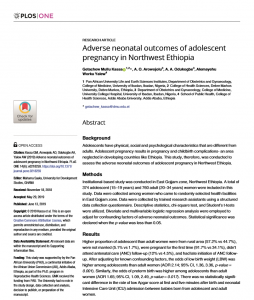
Background
Adolescents have physical, social and psychological characteristics that are different from adults. Adolescent pregnancy results in pregnancy and childbirth complications– an area neglected in developing countries like Ethiopia. This study, therefore, was conducted to assess the adverse neonatal outcomes of adolescent pregnancy in Northwest Ethiopia.
Methods
Institutional-based study was conducted in East Gojjam zone, Northwest Ethiopia. A total of 374 adolescent (15–19 years) and 760 adult (20–34 years) women were included in this study. Data were collected among women who came to randomly selected health facilities in East Gojjam zone. Data were collected by trained research assistants using a structured data collection questionnaire. Descriptive statistics, chi-square test, and Student’s t-tests were utilized. Bivariate and multivariable logistic regression analysis were employed to adjust for confounding factors of adverse neonatal outcomes. Statistical significance was declared when the p-value was less than 0.05.
Results
Higher proportion of adolescent than adult women were from rural area (57.2% vs 44.7%), were not married (5.1% vs 1.7%), were pregnant for the first time (91.7% vs 34.1%), didn’t attend antenatal care (ANC) follow-up (12% vs 4.5%), and had late initiation of ANC follow-up. After adjusting for known confounding factors, the odds of low birth weight (LBW) was higher among adolescents than adult women (AOR 2.14; 95% CI, 1.36, 3.36, p-value = 0.001). Similarly, the odds of preterm birth was higher among adolescents than adult women (AOR 1.65; 95% CI, 1.09, 2.49, p-value = 0.017). There was no statistically significant difference in the rate of low Apgar score at first and five minutes after birth and neonatal Intensive Care Unit (ICU) admission between babies born from adolescent and adult women.
Conclusions
Adolescent women were less likely to receive ANC service. Babies born from adolescent women are at higher odds of adverse neonatal outcomes like LBW and preterm birth than babies born from adult women. Use of community- and health facility-based intervention programs that can prevent adolescent pregnancy and reduce adverse neonatal outcomes among adolescent girls is recommended.